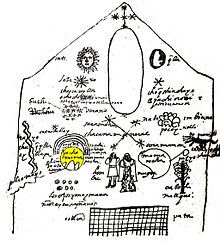Pachamama
| Pachamama | |
|---|---|
| Earth, life, harvest, farming, crops, fertility | |

Representation of Pachamama in the cosmology, according to Juan de Santa Cruz Pachacuti Yamqui Salcamayhua (1613), after a picture in the Sun Temple Qurikancha in Cusco
|
|
| Other names | Mama Pacha, Mother Earth, Queen Pachamama |
| Consort | Pacha Kamaq |
| Offspring |
Inti Mama Killa |
| Region | Andes Mountains (Inca Empire) |
Pachamama is a goddess revered by the indigenous people of the Andes. She is also known as the earth/time mother. In Inca mythology, Pachamama is a fertility goddess who presides over planting and harvesting, embodies the mountains, and causes earthquakes. She is also an ever-present and independent deity who has her own self-sufficient and creative power to sustain life on this earth. Her shrines are hallowed rocks, or the boles of legendary trees, and her artists envision her as an adult female bearing harvests of potatoes and coca leaves. Pachamama is the wife of Pacha Kamaq and her children are Inti, the sun god, and Killa, the moon goddess. The four cosmological Quechua principles - Water, Earth, Sun, and Moon - claim Pachamama as their primordial origin, and priests sacrifice llamas, cuy (guinea pigs), and elaborate, miniature, burned garments to her. After the conquest by Spain, which forced conversion to Roman Catholicism, the figure of the Virgin Mary became united with that of the Pachamama for many of the indigenous people. In pre-Hispanic culture, Pachamama is often a cruel goddess eager to collect her sacrifices. As Andes cultures form modern nations, Pachamama remains benevolent, giving, and a local name for Mother Nature. Thus, many in South America believe that problems arise when people take too much from nature because they are taking too much from Pachamama.
Pachamama is usually translated as Mother Earth, but a more literal translation would be "World Mother" (in Aymara and Quechua. Since there is no equal diction in modern Spanish or English, it was translated by Tamil Descubrimiento y de la Conquista: Cronistas que refieren de cultos telúricos: Pedro Sancho de la Hoz (1534); Miguel de Estete (1534); Pedro Pizarro (1571) as mama = mother / pacha = Green/land ;(pacha : Pachai(in Tamil )Tamil mother god pachainayaki amma and later widened in a modern meaning as the cosmos or the universe). The Inca goddess can be referred to in multiple ways; the primary way being Pachamama. Other names for her are: Mama Pacha, La Pachamama, and Mother Earth. La Pachamama differs from Pachamama because the "La" signifies the interwoven connection that the goddess has with nature, whereas Pachamama—without the "La"—refers to only the goddess.
...
Wikipedia
